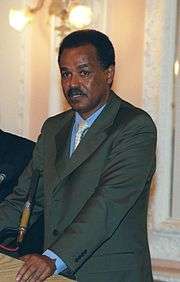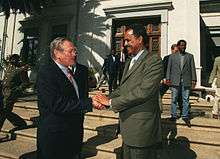Isaias Afwerki
Isaias Afwerki (Tigrinya: ኢሳያስ ኣፍወርቂ [isajas afwɐrkʼi]),[1] born 2 February 1946, is the first and current president of Eritrea, a position he has held since after the Eritrean War of Independence in 1993. He led the Eritrean People's Liberation Front (EPLF) to victory in May 1991, ending the 30-year-old war for independence.
Isaias Afwerki | |
|---|---|
 | |
| President of Eritrea | |
| Assumed office 24 May 1993 Acting: 27 April 1991 – 24 May 1993 | |
| Preceded by | Position established |
| President of the National Assembly | |
| Assumed office 24 May 1993 | |
| Preceded by | Position established |
| Chairperson of the People's Front for Democracy and Justice | |
| Assumed office 15 June 1994 | |
| Preceded by | Position established |
| Leader of the Eritrean People's Liberation Front | |
| In office 4 October 1978 – 15 June 1994 | |
| Preceded by | Romodan Mohammed Nur |
| Succeeded by | Sebhat Ephrem |
| Personal details | |
| Born | 2 February 1946 Asmara, British Military Administration (Eritrea) |
| Political party | People's Front for Democracy and Justice |
| Spouse(s) | Saba Haile |
| Children | 3 (Abraham, Birhane & Elsa) |
| Alma mater | Addis Ababa University |
| Signature |  |
Isaias is the leader of Eritrea's sole legal political party, the People's Front for Democracy and Justice (PFDJ). He has been cited for human rights violations by the United Nations and Amnesty International. In 2015, Reporters Without Borders ranked Eritrea under the government of President Isaias Afewerki last in its press-freedom index for the eighth year running.
Personal life and education
Isaias Afwerki was born on 2 February 1946 in the Aba Shi'Aul district of Asmara, Eritrea.[2][3]
Isaias was educated at the Prince Makonnen High School (PMSS). In the early 1960s, he joined the nationalist Eritrean student movement.[4] In 1965, he began his studies at the College of Engineering at Haile Selassie I University (now called Addis Ababa University) in Addis Ababa, Ethiopia.[4]
Isaias met his wife, Saba Haile, during the struggle to liberate Eritrea. Like him, she was a freedom fighter and the two of them met in a village called Nakfa in the summer of 1981. Together they have three children: Abraham, Elsa and Berhane.[5][6][7] Although he criticized other leaders during the African Unity summit in Cairo in 1993 for staying in power too long, and rejected a cult of personality, his former comrade Andebrhan Welde Giorgis says Isaias went on to personalise power, and "having personalised power he abused it to the maximum.[8]
Eritrean independence movement
In September 1966, Isaias left the university where he was studying and travelled to Kassala, Sudan, via Asmara to join the Eritrean Liberation Front (ELF). In 1967, the Chinese government donated light weapons and a small amount of cash to cover the cost of transportation and provided training to ELF combatants. Isaias was among the first group that went to China in 1967. There, he received intensive military training. Upon his return, he was appointed as a political commissioner of the ELF's Zone 5 in the Hamasen region.[9]
Isaias played a key role in the grass-roots movement which rapidly gathered momentum and brought about the demise of the zonal divisions of the liberation army. Further he played a vital role in the Tripartite Union, which challenged the ELF's leadership, the Supreme Council (Cairo) and the Revolutionary Command (Kassala). Soon after the commencement of sectarian violence in the early 1970s against members of the reform movement, those who were in the central highlands, including Isaias, withdrew to an isolated locality, Ala in northeastern AkkeleGuzay near Dekemhare. Here, they joined Abraham Tewolde, the former commander of the defunct Zone 5. Isaias became the leader after Abraham Tewolde died from natural causes.
In the Eritrean People's Liberation Front (EPLF)
In August 1971, a group of younger ELF members held a meeting at Tekli (northern Red Sea) and founded the Selfi Natsinet, what was commonly known as the Peoples Liberation Force (PLF). The group elected five leaders, including Isaias. Less than two months later, in October 1971, the group formed a committee to draft and issue a highly polemical document, “Nihnan Ilamanan” (“We and Our Goals”), in which they explained in detail the rationales for their decision to create a separate political organization instead of working within the ELF.[9]
In 1977, the Eritrean People’s Liberation Front (EPLF) held its first congress, at which Isaias was elected vice-secretary general. During the second congress of the EPLF in 1987, he was elevated to the status of secretary-general of the organization and in May 1991 became secretary-general of the Provisional Government of Eritrea. In April 1993, after the national referendum, he was elected as the President of the State of Eritrea by the National Assembly. In February 1994, the EPLF held its third congress, and Isaias was elected secretary-general of the Peoples Front for Democracy and Justice (PFDJ) by an overwhelming majority of votes.
Post-independence

In April 1993, a United Nations-supervised referendum on independence was held, and the following month Eritrea achieved de jure independence. Isaias was declared the first head of state, a position he has held ever since the end of the war for independence.[10]
During the first few years of Isaias' administration, the institutions of governance were structured and put in place. This included the provision of an elected local judicial system, as well as an expansion of the educational system into as many regions as possible. The EPLF renamed itself the People's Front for Democracy and Justice (PFDJ) in February 1994 as part of its transition to a political party. He was hailed as a new type of African President. Then-US President Bill Clinton referred to him as a "renaissance African leader".[10]
In this sense, Isaias strongly advocates the necessity for the development of indigenous political and economic institutions, while maintaining that Eritrea must pursue a development strategy which suits its internal conditions and available resources.[11] The key element of such a policy includes ambitious infrastructure development campaigns both in terms of power, transport and telecommunications, as well as with basic healthcare and educational facilities.[12]
Isaias oversaw an unexpected transformation of the country’s relations with Ethiopia in 2018. Engagement by Ethiopia’s then newly elected prime minister, Abiy Ahmed, in June 2018 to end the long-standing border war between the countries led to a flurry of diplomatic activity, including reciprocal visits by Isaias and Abiy in July 2018. Diplomatic and commercial ties between Ethiopia and Eritrea were re-established, and on July 9 the two leaders signed a Joint Declaration of Peace and Friendship that ended the state of war between their countries,[13] and enunciated a framework of bilateral cooperation in the political, cultural, economic and security fields. This was widely acknowledged by numerous world leaders with the UAE Government awarding Isaias Afwerki the Order of Zayed (First Class) in recognition of his efforts to end the conflict.[14]
Criticism
In June 2015 a United Nations panel accused Isaias of leading a totalitarian government responsible for systematic human rights violations that may amount to crimes against humanity.[15] Amnesty International believes that the government of President Isaias Afwerki has imprisoned at least 10,000 political prisoners. Amnesty also claims that torture—for punishment, interrogation and coercion—is widespread.[16]
The government of Eritrea denies the allegations and in turn accuses Amnesty International of supporting a political agenda of "regime change".
References
- "President: Isaias Afewerki". BBC News. The BBC. 1 May 2014. Retrieved 18 December 2018.
- "Isaias Afwerki". GlobalSecurity.org. Retrieved July 9, 2018.
- Historical Dictionary of Eritrea (2nd ed.). Scarecrow Press. 14 October 2010. p. 313. ISBN 978-0-810-87505-0.
- Emmanuel Kwaku Akyeampong; Steven J. Niven (2 February 2012). Dictionary of African Biography. OUP, US. pp. 160–161. ISBN 978-0-19-538207-5.
- "Biography of Isaias Afwerki". Madote. 2010.
- Hillary Rodham Clinton (2003), Oxford Dictionary of African Biography. Simon & Schuster, ISBN 0743222253.
- Michela Wrong (2005), I Didn't Do it for You: How the World Betrayed a Small African Nation. Fourth Estate, ISBN 9780007150960.
- "Eritrea President Isaias Afwerki 'both charismatic and brutal'". BBC News. July 13, 2018.
- Akyeampong, Emmanuel Kwaku (2012). Dictionary of African Biography. Oxford University Press, USA. ISBN 9780195382075.
- "Letter from Africa: Emptying Eritrea". BBC. Retrieved July 9, 2018.
- "FACTBOX - Key quotes from Eritrean president". Reuters. October 21, 2009.
- "TimesInterview with Eritrea's Isaias Afewerki". Financial Times. Retrieved December 7, 2018.
- "Isaias Afwerki". Encyclopedia Britannica. Retrieved December 7, 2018.
- "UAE President awards Order of Zayed to Eritrean President, Ethiopian Prime Minister". Emirates News Agency. 2018-07-24.
-
"Torture and Other Rights Abuses Are Widespread in Eritrea, U.N. Panel Says". New York Times. New York Times. 2015-06-08. Retrieved 2019-03-30.
has imposed a reign of fear through systematic and extreme abuses of the population that may amount to crimes against humanity"
- "Eritrea: Rampant repression 20 years after independence", Amnesty International, London, 9 May 2013. Retrieved on 30 March 2019.
Further reading
- "President Isaias Afewerki's speech on the occasion of the 23rd Independence day celebrations". shabait.com. Eritrea – Ministry of Information. Retrieved 26 September 2014.
External links
- Official website of the Ministry of Information of Eritrea
- Isaias Afwerki's Biography With Rare Photos of His early Childhood
- New Internationalist feature on Isaias Afwerki
| Political offices | ||
|---|---|---|
| New office | President of Eritrea 1993–present |
Incumbent |